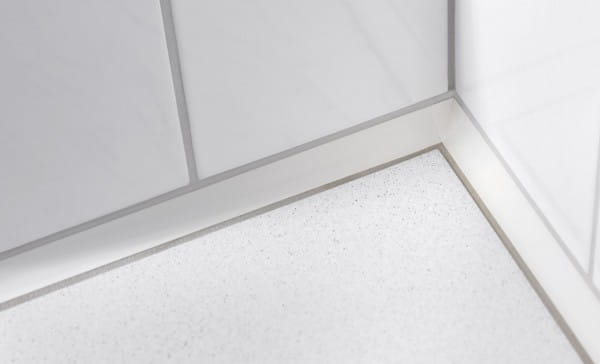You want to install tile profiles or skirting boards in your house? Have you already thought about how many skirting boards you need or want to lay one after the other? Because, in order to achieve the best possible result for your premises, it is usually necessary to cut or connect the tile profiles.
Connecting profiles
If you want to connect your tile moldings or baseboards together, you have two options:
- Miter cut
- Connector, inner and outer corners for skirting boards/ tile profiles
Miter cut
If you want to join two tile moldings neatly at an angle, you need to miter cut the two moldings. The two moldings meet at the corner at a 90 degree angle. If you cut the two moldings at a 45 degree angle each so that they fit together perfectly, you will get a perfect miter.
The important thing to remember when mitering is that both tile borders together make the angle you need. Most of the time you can get by with the 45 degree cut, but not every room has right angles. Especially in old buildings it happens more often that room corners are somewhat crooked. There you have to deviate a little from the standard 45 degrees.
Advantages miter cut:
- You get a uniform, beautiful appearance without additional connecting pieces.
- The miter increases the connection area, which also increases stability.
- One saves money on further additional materials, such as connectors/inner or outer corners.
What should be considered?
 Outside corner instead of miter cut
Outside corner instead of miter cutJust laid a new floor, but then poorly cut baseboards ruin the beautiful look?
Good preparatory work also makes things easier for you here. The angle should be measured really accurately - if necessary, even several times to ensure that it has the correct dimensions. Believe, there is nothing more annoying than when you realize after sawing that the freshly cut moldings are not a perfect fit.
To prevent this from happening, slow and steady work is very important. The cuts should be made very precisely so that a satisfactory result is achieved afterwards.
Such precise work has to be learned. For this reason, it is useful to practice different miter angles and combinations before starting the actual work.
What tools are needed?
In principle, you can cut a miter with any type of saw that is suitable for working with metal or plastic. It is important that the chosen tool fits the material and that the necessary miter angle can be maintained.
If you want to use a saw without a fixed guide, we recommend the so-called miter box. A miter box is usually made of plastic or wood and has predetermined saw guides.
Another tool that makes the work easier is the miter box. You can use the miter box to transfer angles to a workpiece. A bevel is essential for measuring the miter angle.
Miter sawing - instructions
- Measuring angles: Do the preliminary work - the correct angle should be measured exactly. Often it is the angle cut of 45 degrees, but still it is important to check the exact angle.
- Transfer angle to workpiece: you can easily transfer the miter angle to the tile border with the miter saw. Mark the spot.
- Set miter angle on saw: Depending on the type of saw you have chosen, this is done in different ways.
- Fix the workpiece: Fasten or clamp the tile molding in place so it doesn't slip out of place while you're sawing.
- Miter cutting: Before you cut, carefully check all the settings again. If everything is correct, work slowly and accurately.
Connector instead of miter cut
 Connector for skirting board
Connector for skirting boardWe also offer various accessories for the tile skirting in our online store. From corners for tile profiles to connectors skirting silver brushed, everything is there. The connectors for skirting boards, or the inner and outer corners for tile profiles are perfect if you want to connect two tile skirting boards.
We recommend our inner corners because they are visually attractive, waterproof and technically ideal to provide the best grip.
Likewise, we also have connectors for skirting boards in our range, matching the particular variant you choose. For example, if you choose the skirting board cable channel silver, of course, the connector also has a cable channel.
Miter cut yes or no?
Whether you choose miter cut or tile profile corners, both have their advantages and disadvantages. Miter cutting requires good, precise work. One little careless mistake and you can start over. With tile profile corners, of course, you have more costs due to additional material, but in the process, the installation is also relatively simple.
Hints:
In general, the generally accepted rules of technology must be observed!
The following applies to all products/materials: The usability with regard to mechanical and chemical loads must be carefully checked in each individual case before installation. Protect material from prolonged exposure to sunlight.
If you have any questions, please do not hesitate to contact us.
We wish you success
the team of alleszumfliesen.de


